Simultaneously Enhanced Strength, Toughness and Ductility of Cast 40Cr Steels Strengthened by Trace Biphase TiCx-TiB2 Nanoparticles
Abstract
1. Introduction
2. Materials and Methods
3. Results and Discussion
4. Conclusions
Author Contributions
Funding
Acknowledgments
Conflicts of Interest
References
- Hong, S.-M.; Park, E.-K.; Park, J.-J.; Lee, M.-K.; Gu Lee, J. Effect of nano-sized TiC particle addition on microstructure and mechanical properties of SA-106B carbon steel. Mater. Sci. Eng. A 2015, 643, 37–46. [Google Scholar] [CrossRef]
- Xu, Z.; Liang, G.; Guan, Q.; Jiang, Q. TiC as heterogeneous nuclei of the (Fe, Mn)3C and austenite intergrowth eutectic in austenite steel matrix wear resistant composite. Mater. Res. Bull. 2004, 39, 457–463. [Google Scholar] [CrossRef]
- Akhtar, F. Microstructure evolution and wear properties of in situ synthesized TiB2 and TiC reinforced steel matrix composites. J. Alloys Compd. 2008, 459, 491–497. [Google Scholar] [CrossRef]
- Fedrizzi, A.; Pellizzari, M.; Zadra, M.; Marin, E. Microstructural study and densification analysis of hot work tool steel matrix composites reinforced with TiB2 particles. Mater. Charact. 2013, 86, 69–79. [Google Scholar] [CrossRef]
- Wang, K.; Jiang, H.Y.; Wang, Y.X.; Wang, Q.D.; Ye, B.; Ding, W.J. Microstructure and mechanical properties of hypoeutectic Al–Si composite reinforced with TiCN nanoparticles. Mater. Des. 2016, 95, 545–554. [Google Scholar] [CrossRef]
- Zhu, H.-W.; Xu, K.; Qin, S.; Xiao, F.-R.; Liao, B. Effect of heat treatment on microstructure and properties of 1045 steel modified with (NbTi)C nanoparticles. Mater. Sci. Eng. A 2018, 728, 175–182. [Google Scholar] [CrossRef]
- Qiu, F.; Gao, X.; Tang, J.; Gao, Y.-Y.; Shu, S.-L.; Han, X.; Li, Q.; Jiang, Q.-C. Microstructures and tensile properties of Al–Cu matrix composites reinforced with nano-sized sicp fabricated by semisolid stirring process. Metals 2017, 7, 49. [Google Scholar] [CrossRef]
- Mei, Z.; Yan, Y.W.; Cui, K. Effect of matrix composition on the microstructure of in situ synthesized TiC particulate reinforced iron-based composites. Mater. Lett. 2003, 57, 3175–3181. [Google Scholar] [CrossRef]
- Akhtar, F.; Guo, S.J. Microstructure, mechanical and fretting wear properties of TiC-stainless steel composites. Mater. Charact. 2008, 59, 84–90. [Google Scholar] [CrossRef]
- Lazarova, R.; Petrov, R.H.; Gaydarova, V.; Davidkov, A.; Alexeev, A.; Manchev, M.; Manolov, V. Microstructure and mechanical properties of P265GH cast steel after modification with TiCN particles. Mater. Des. 2011, 32, 2734–2741. [Google Scholar] [CrossRef]
- Cha, L.; Lartigue-Korinek, S.; Walls, M.; Mazerolles, L. Interface structure and chemistry in a novel steel-based composite Fe-TiB2 obtained by eutectic solidification. Acta Mater. 2012, 60, 6382–6389. [Google Scholar] [CrossRef]
- Greer, A.L. Overview: Application of heterogeneous nucleation in grain-refining of metals. J. Chem. Phys. 2016, 145, 211704. [Google Scholar] [CrossRef] [PubMed]
- AlMangour, B.; Baek, M.-S.; Grzesiak, D.; Lee, K.-A. Strengthening of stainless steel by titanium carbide addition and grain refinement during selective laser melting. Mater. Sci. Eng. A 2018, 712, 812–818. [Google Scholar] [CrossRef]
- Tian, W.-S.; Zhao, Q.-L.; Zhang, Q.-Q.; Qiu, F.; Jiang, Q.-C. Simultaneously increasing the high-temperature tensile strength and ductility of nano-sized TiCp reinforced Al-Cu matrix composites. Mater. Sci. Eng. A 2018, 717, 105–112. [Google Scholar] [CrossRef]
- Tian, W.-S.; Zhao, Q.-L.; Zhang, Q.-Q.; Qiu, F.; Jiang, Q.-C. Enhanced strength and ductility at room and elevated temperatures of Al-Cu alloy matrix composites reinforced with bimodal-sized TiCp compared with monomodal-sized TiCp. Mater. Sci. Eng. A 2018, 724, 368–375. [Google Scholar] [CrossRef]
- Park, J.-J.; Hong, S.-M.; Park, E.-K.; Kim, K.-Y.; Lee, M.-K.; Rhee, C.-K. Microstructure and properties of SA 106B carbon steel after treatment of the melt with nano-sized TiC particles. Mater. Sci. Eng. A 2014, 613, 217–223. [Google Scholar] [CrossRef]
- Hu, S.W.; Zhao, Y.G.; Wang, Z.; Li, Y.G.; Jiang, Q.C. Fabrication of in situ TiC locally reinforced manganese steel matrix composite via combustion synthesis during casting. Mater. Des. 2013, 44, 340–345. [Google Scholar] [CrossRef]
- Vallauri, D.; Atías Adrián, I.C.; Chrysanthou, A. TiC–TiB2 composites: A review of phase relationships, processing and properties. J. Eur. Ceram. Soc. 2008, 28, 1697–1713. [Google Scholar] [CrossRef]
- Grützner, S.; Krüger, L.; Radajewski, M.; Schneider, I. Characterization of in-situ TiB/TiC particle-reinforced Ti-5Al-5Mo-5V-3Cr matrix composites synthesized by solid-state reaction with B4C and graphite through SPS. Metals 2018, 8, 377. [Google Scholar] [CrossRef]
- Kumar, R.; Chaubey, A.; Maity, T.; Prashanth, K. Mechanical and tribological properties of Al2O3-TiC composite fabricated by spark plasma sintering process with metallic (Ni, Nb) binders. Metals 2018, 8, 50. [Google Scholar] [CrossRef]
- Li, B.; Liu, Y.; Li, J.; Cao, H.; He, L. Effect of sintering process on the microstructures and properties of in situ TiB2–TiC reinforced steel matrix composites produced by spark plasma sintering. J. Mater. Process. Technol. 2010, 210, 91–95. [Google Scholar] [CrossRef]
- Zhu, H.; Dong, K.; Wang, H.; Huang, J.; Li, J.; Xie, Z. Reaction mechanisms of the TiC/Fe composite fabricated by exothermic dispersion from Fe–Ti–C element system. Powder Technol. 2013, 246, 456–461. [Google Scholar] [CrossRef]
- Lee, S.H.; Hong, S.M.; Han, B.S.; Park, J.J.; Lee, J.K.; Lee, J.G.; Lee, M.K.; Rhee, C.K. Homogeneous dispersion of TiC nano particles in a cast carbon steel matrix. J. Nanosci. Nanotechnol. 2010, 10, 258–262. [Google Scholar] [CrossRef] [PubMed]
- Cojocaru, V.D.; Răducanu, D.; Angelescu, M.L.; Vintilă, A.N.; Şerban, N.; Dan, I.; Cojocaru, E.M.; Cinca, I. Influence of solution treatment duration on microstructural features of an industrial forged UNS S32750/1.4410/F53 super duplex stainless steel (SDSS). Alloys JOM 2017, 69, 1439–1445. [Google Scholar] [CrossRef]
- Cojocaru, V.; Șerban, N.; Angelescu, M.; Cotruț, M.; Cojocaru, E.; Vintilă, A. Influence of solution treatment temperature on microstructural properties of an industrially forged UNS S32750/1.4410/F53 super duplex stainless steel (SDSS) alloy. Metals 2017, 7, 210. [Google Scholar] [CrossRef]
- Angelescu, M.; Cojocaru, V.; Șerban, N.; Cojocaru, E. Evaluation of optimal forging temperature range for an industrial UNS S32750 SDSS alloy using SEM-EBSD analysis. Metals 2018, 8, 496. [Google Scholar] [CrossRef]
- AlMangour, B.; Grzesiak, D.; Yang, J.-M. Nanocrystalline TiC-reinforced H13 steel matrix nanocomposites fabricated by selective laser melting. Mater. Des. 2016, 96, 150–161. [Google Scholar] [CrossRef]
- Zhao, J.; Jiang, Z.; Lee, C.S. Enhancing impact fracture toughness and tensile properties of a microalloyed cast steel by hot forging and post-forging heat treatment processes. Mater. Des. 2013, 47, 227–233. [Google Scholar] [CrossRef]
- Seok, M.-Y.; Choi, I.-C.; Moon, J.; Kim, S.; Ramamurty, U.; Jang, J.-I. Estimation of the Hall–Petch strengthening coefficient of steels through nanoindentation. Scr. Mater. 2014, 87, 49–52. [Google Scholar] [CrossRef]
- Han, Y.; Shi, J.; Xu, L.; Cao, W.Q.; Dong, H. TiC precipitation induced effect on microstructure and mechanical properties in low carbon medium manganese steel. Mater. Sci. Eng. A 2011, 530, 643–651. [Google Scholar] [CrossRef]
- Honga, S.G.; Kangb, K.B.; Parka, C.G. Strain-induced precipitation of NbC in Nb and Nb-Ti microalloyed HSLA steels. Scr. Mater. 2002, 46, 163–168. [Google Scholar] [CrossRef]
- Arzt, E. Size effects in materials due to microstructural and dimensional constraints: A comparative review. Acta Mater. 1998, 46, 5611–5626. [Google Scholar] [CrossRef]
- Wang, T.-P.; Kao, F.-H.; Wang, S.-H.; Yang, J.-R.; Huang, C.-Y.; Chen, H.-R. Isothermal treatment influence on nanometer-size carbide precipitation of titanium-bearing low carbon steel. Mater. Lett. 2011, 65, 396–399. [Google Scholar] [CrossRef]
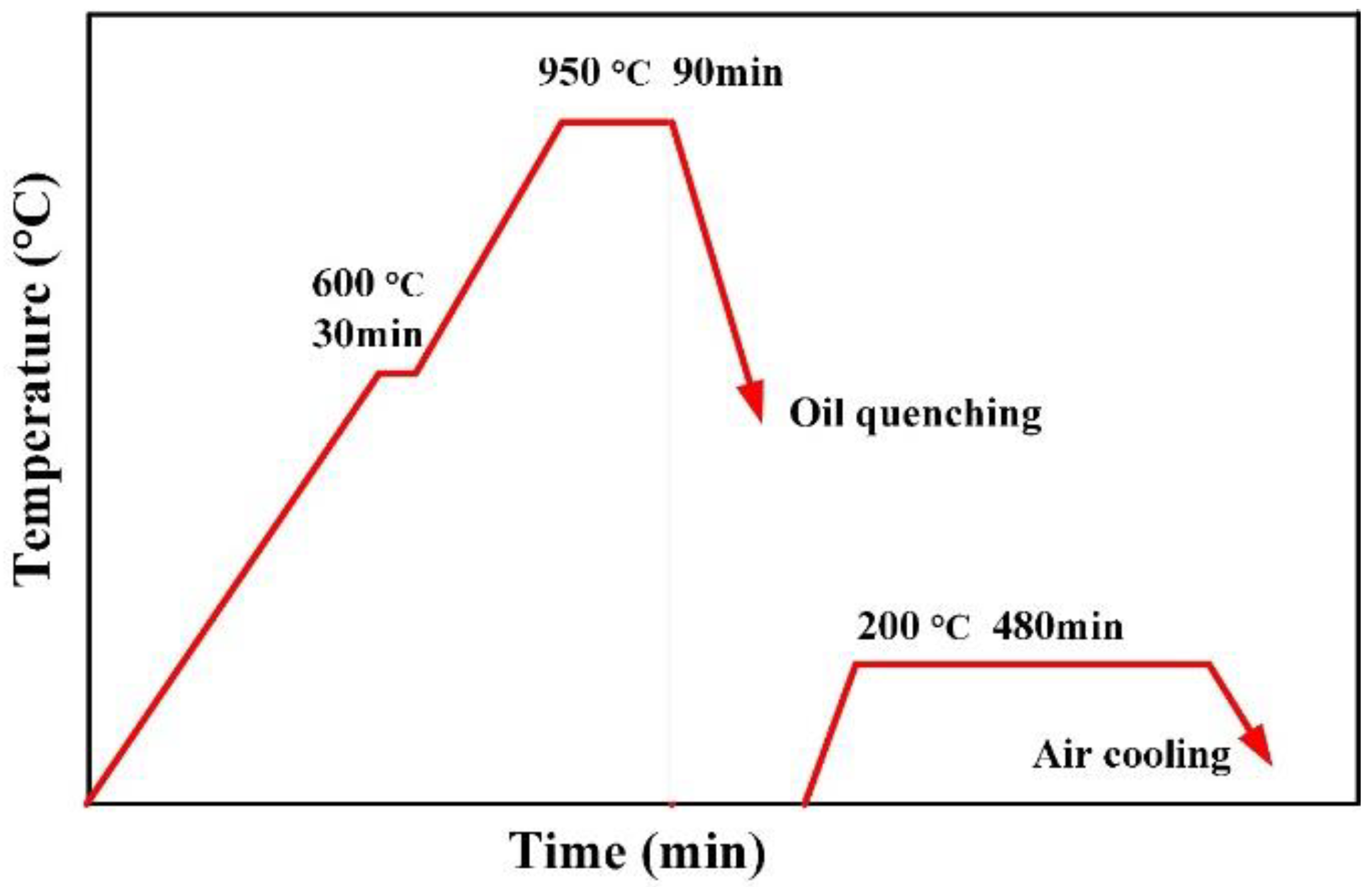
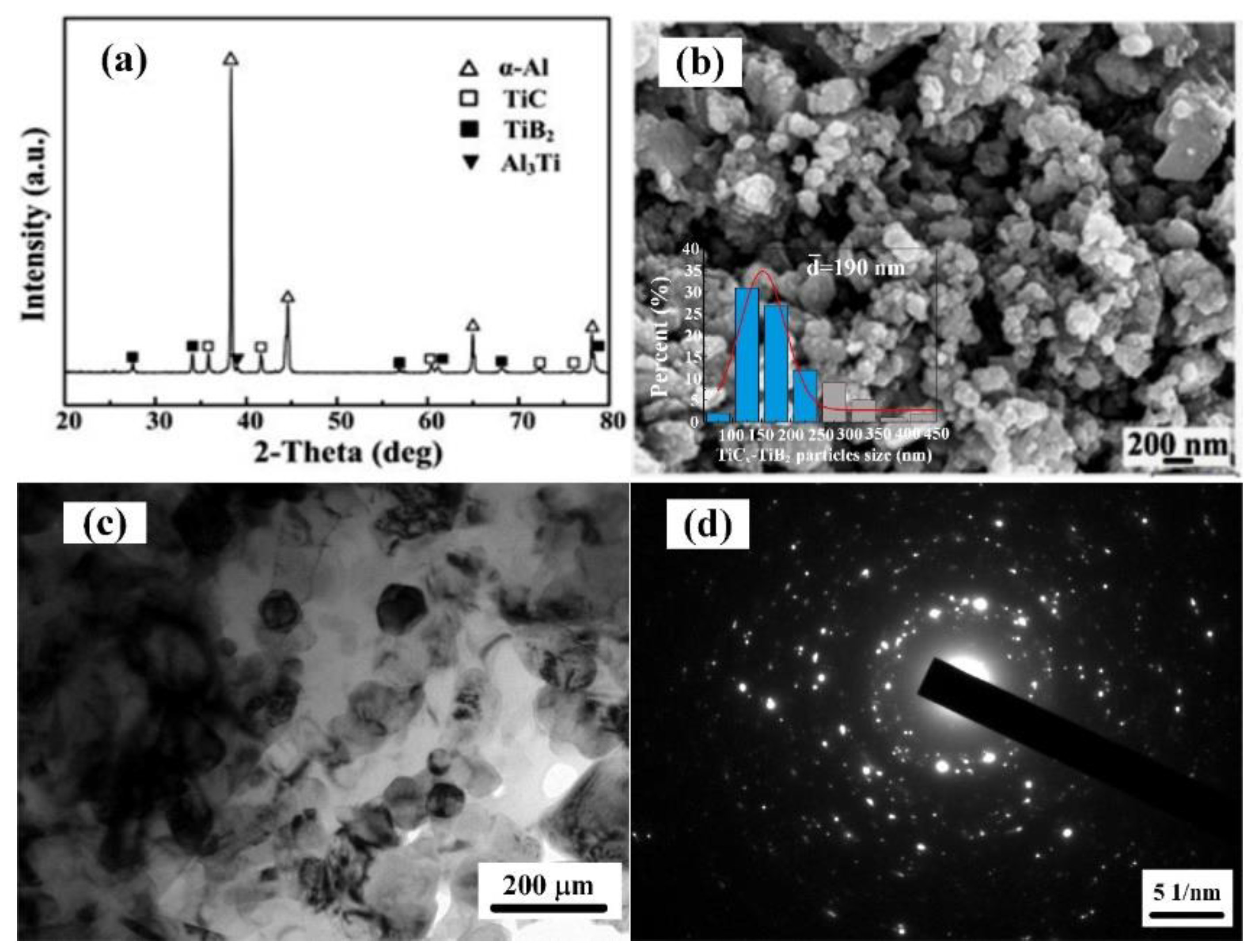
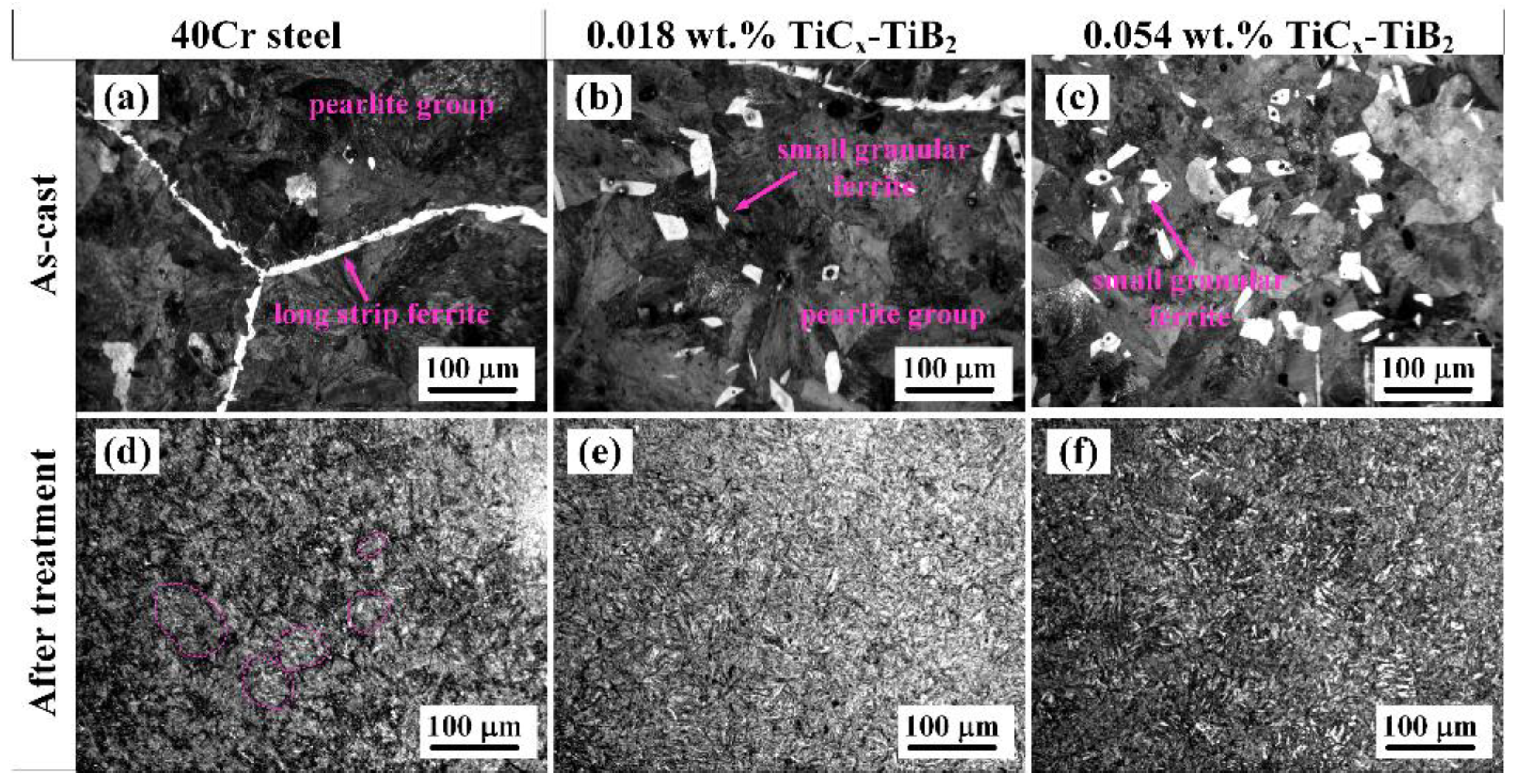

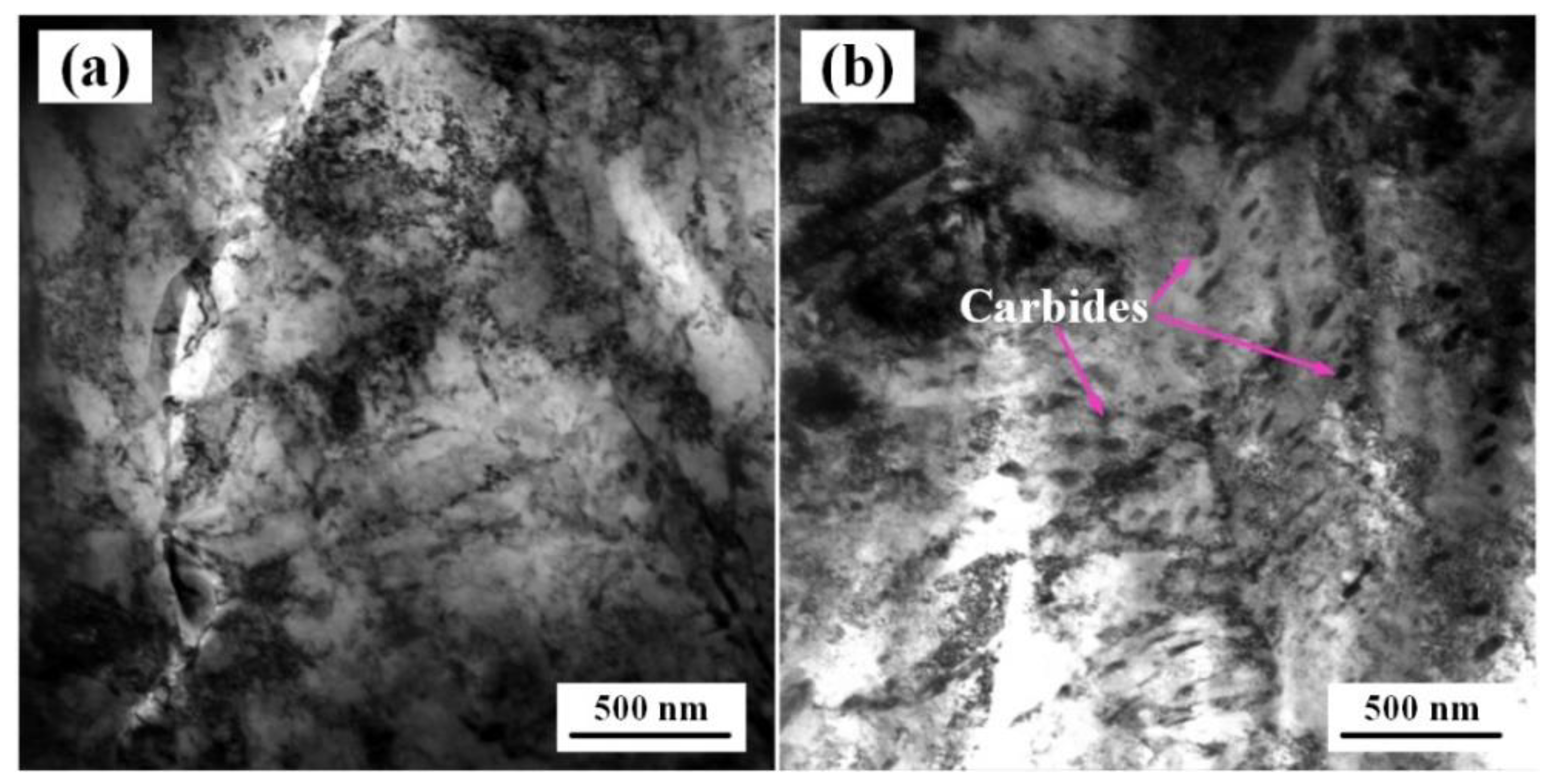

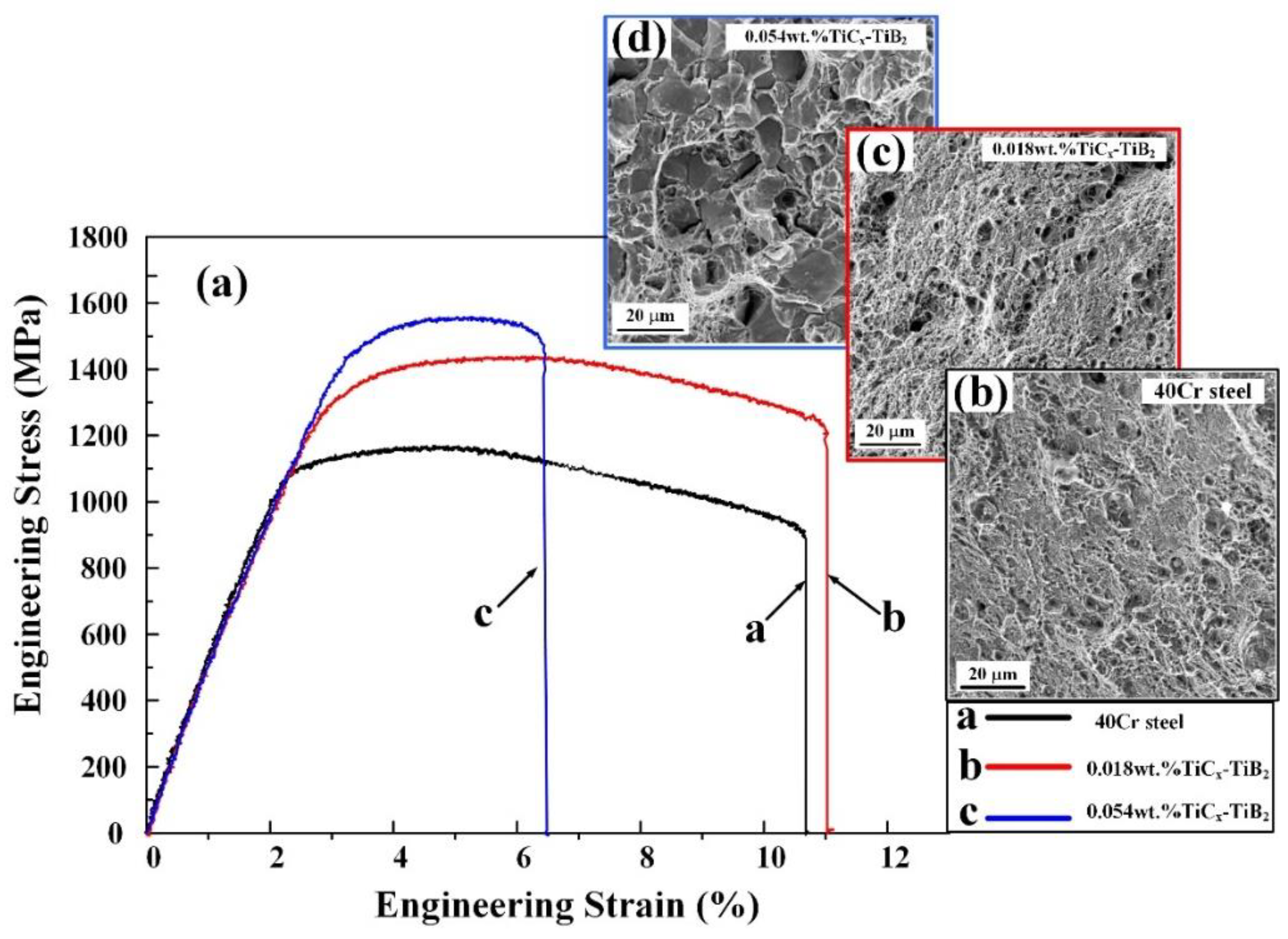
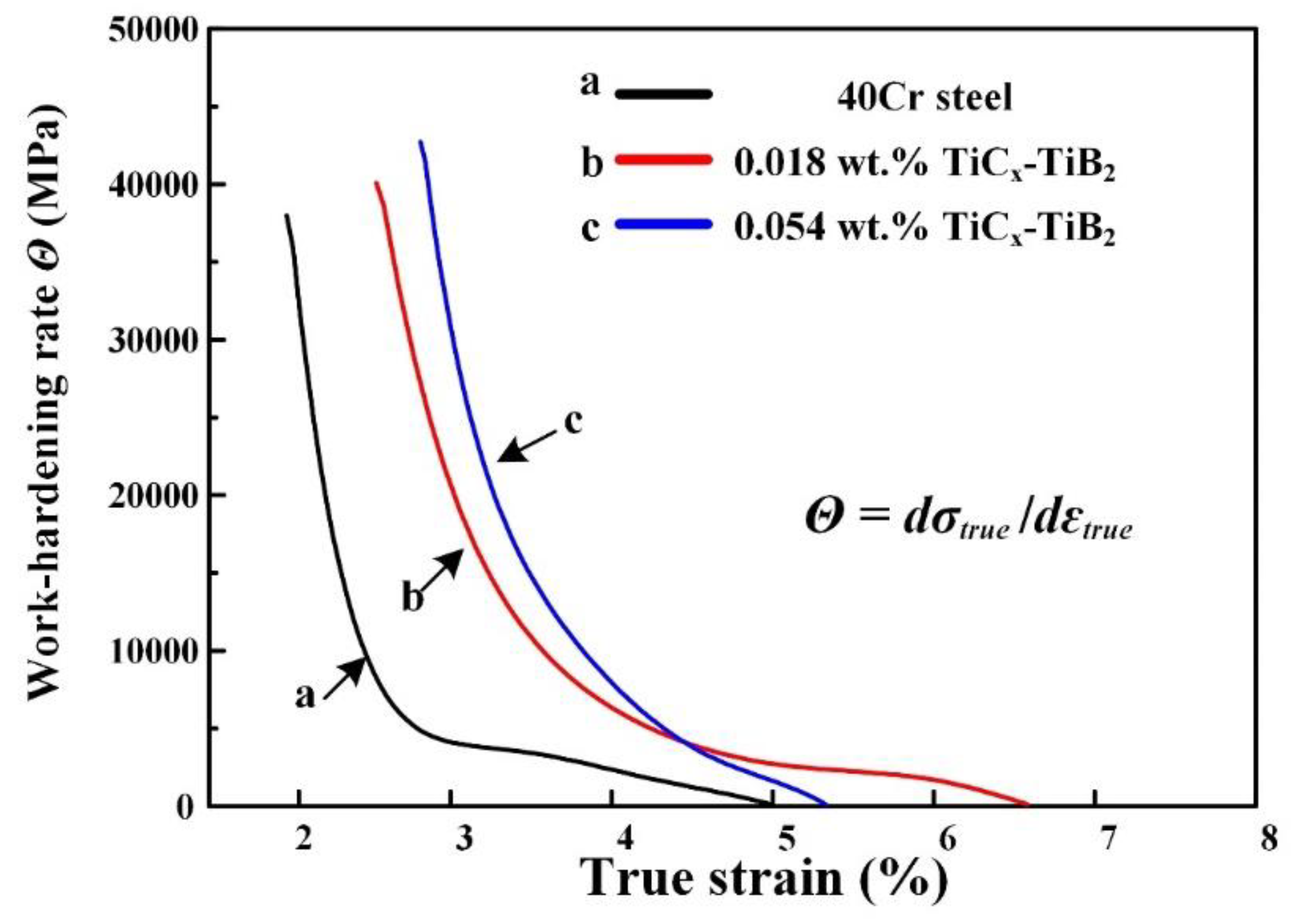
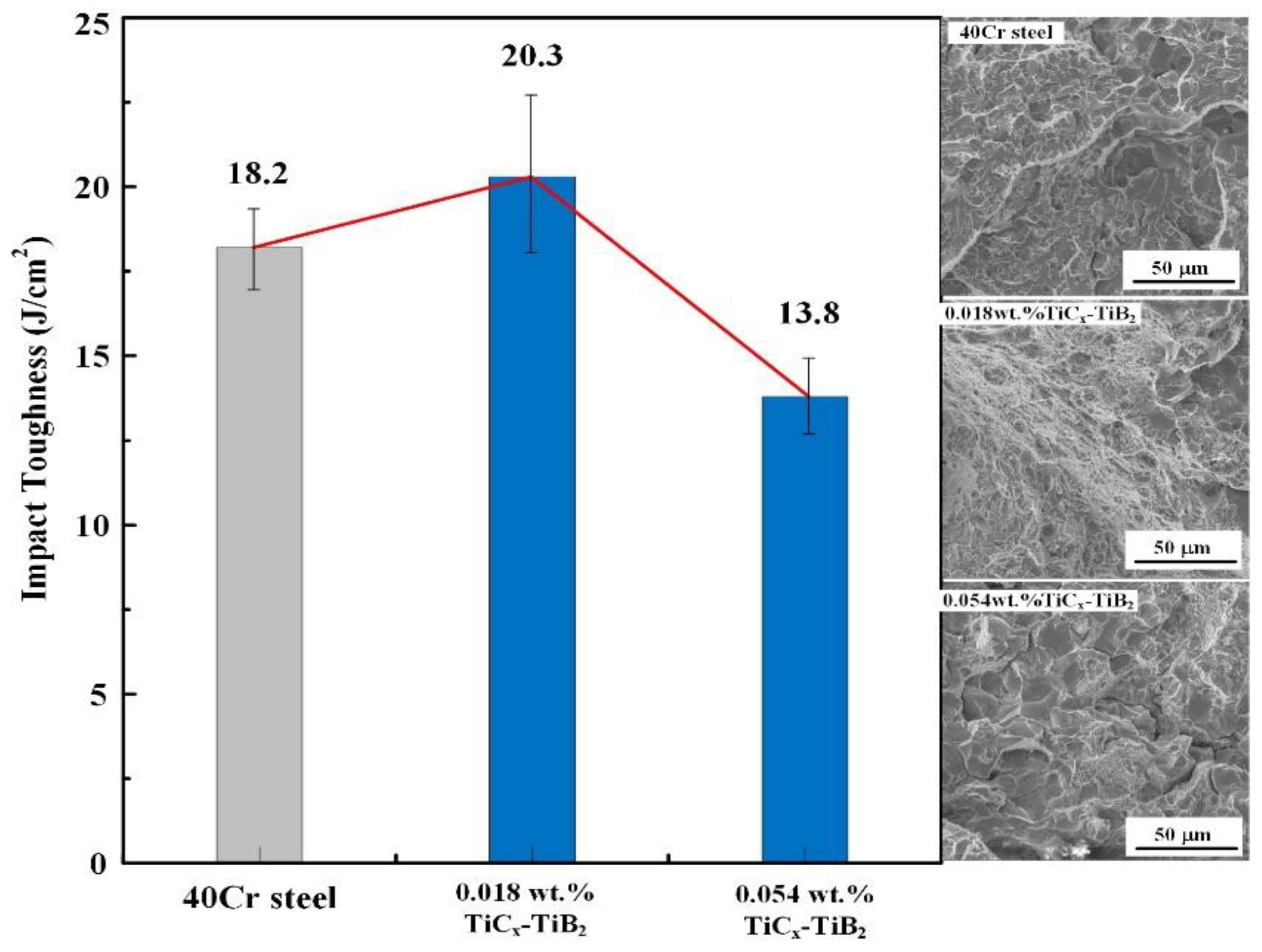
| Element | C | Si | Mn | Cr | S | P | Fe |
|---|---|---|---|---|---|---|---|
| wt.% | 0.41 | 0.25 | 0.65 | 0.95 | 0.004 | 0.018 | Bal. |
| Samples | σ0.2 (MPa) | σUTS (MPa) | Fracture Strain εf (%) | ak (J/cm2) | Hardness HRC |
|---|---|---|---|---|---|
| 40Cr steels | 18.2 ± 0.85 | ||||
| 0.018 wt.% TiCx + TiB2 | 9. | 20.3 ± 1.66 | |||
| 0.054 wt.% TiCx + TiB2 | 5. | 13.8 ± 0.80 |
© 2018 by the authors. Licensee MDPI, Basel, Switzerland. This article is an open access article distributed under the terms and conditions of the Creative Commons Attribution (CC BY) license (http://creativecommons.org/licenses/by/4.0/).
Share and Cite
Li, C.-L.; Qiu, F.; Chang, F.; Zhao, X.-M.; Geng, R.; Yang, H.-Y.; Zhao, Q.-L.; Jiang, Q.-C. Simultaneously Enhanced Strength, Toughness and Ductility of Cast 40Cr Steels Strengthened by Trace Biphase TiCx-TiB2 Nanoparticles. Metals 2018, 8, 707. https://doi.org/10.3390/met8090707
Li C-L, Qiu F, Chang F, Zhao X-M, Geng R, Yang H-Y, Zhao Q-L, Jiang Q-C. Simultaneously Enhanced Strength, Toughness and Ductility of Cast 40Cr Steels Strengthened by Trace Biphase TiCx-TiB2 Nanoparticles. Metals. 2018; 8(9):707. https://doi.org/10.3390/met8090707
Chicago/Turabian StyleLi, Chuan-Lu, Feng Qiu, Fang Chang, Xu-Min Zhao, Run Geng, Hong-Yu Yang, Qing-Long Zhao, and Qi-Chuan Jiang. 2018. "Simultaneously Enhanced Strength, Toughness and Ductility of Cast 40Cr Steels Strengthened by Trace Biphase TiCx-TiB2 Nanoparticles" Metals 8, no. 9: 707. https://doi.org/10.3390/met8090707
APA StyleLi, C.-L., Qiu, F., Chang, F., Zhao, X.-M., Geng, R., Yang, H.-Y., Zhao, Q.-L., & Jiang, Q.-C. (2018). Simultaneously Enhanced Strength, Toughness and Ductility of Cast 40Cr Steels Strengthened by Trace Biphase TiCx-TiB2 Nanoparticles. Metals, 8(9), 707. https://doi.org/10.3390/met8090707






